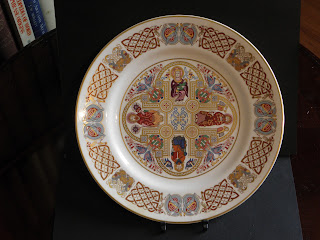There
are many contenders for the title of the ‘most beautiful book in the world’ but
for my money the winner is most definitely the Book of Kells. The book was
produced just before 800 CE and currently consists of 340 folios bound into
four volumes (some pages have been lost and it has been rebound several times).
It is made up of the four gospels, largely from St. Jerome’s Vulgate Bible,
with some other passages taken mainly from the earlier Vetus Latina texts. It
is the culmination of the Insular Style of illuminated manuscripts.
 |
| The Beatitudes - folio 40 verso |
Exactly
where the book was made is open to debate, but Iona seems to be the most likely
candidate, with the book and other treasures being moved by the monks when the
Viking raids began there in 794. It takes its name from the Abbey of Kells,
County Meath, where it was housed for most of the medieval period. In 1654, it
was moved to Dublin, (as Cromwell’s troops were in Kells at the time…), and
presented in 1661 to Trinity College, Dublin, where it remains to this day (on
show, and well worth a visit, if you’re ever in Dublin). There are only two
single colour pages in the book, the rest have some decoration or other, but
the true glories are the full-page illuminations, perhaps the greatest of which
is the Chi-Rho page (folio 34 r), one of the treasures of Western Art.
 |
| Chi-Rho page |
The intricate knot-work is so dense it can
only be properly appreciated with a lens (which, at the time it was made, were
not known), and features writhing animals and human figures, interlaced with
abstract patterns and strap-work. The first mention of the book is in the
Annals of Ulster, in the year 1007 it is reported as being stolen, “The great
Gospel of Colum-Cille was wickedly stolen in the night out of the western
sacristy of the great stone-church of Cenannas - the chief relic of the western
world, on account of its ornamental cover. The same Gospel was found after
twenty [nights] and two months, its gold having been taken off it, and a sod
over it.”
 |
| Annals of Ulster entry detailing the theft. |
It is interesting that it was stolen from the church, rather than a
library or scriptorium, suggesting it was being used in worship. The
illuminations have had an enormous influence on later Celtic art.
Here is a
pewter pill box, made by A E Williams.
Of the many other things I have with Kells
connotations, I have a plate made by Spode.
And a plate made by Nexus Pottery,
Northumberland, a limited edition of 5000, of which this is number 252.
The plates on the wall.
This is
a small book with illustrations from the book, which I like very much.





No comments:
Post a Comment